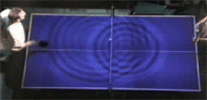Students in the New Interfaces for Musical Expression course at NYU have rigged up a ping-pong sample playback controller. The ping-pong paddles have piezo sensors in them and when they hit the ball, they would actuate the starting and ending points of a sample – so the faster they play, the more frantic the sonic output.
![50r8sj[1].jpg](http://www.we-make-money-not-art.com/yyy/50r8sj%5B1%5D.jpg)
Via Create Digital Music MusicThing.
Made me think of one of the interaction design classics (1998): PingPongPlus , a digitally enhanced version of a ping-pong game, that is played with ordinary paddles and balls, and features a “reactive table” that incorporates sensing, sound, ball tracking and projection technologies. Projectors display patterns of light and shadow on the table; bouncing balls leave images of rippling water (or thunderstorm, paintings, comets, or black-out); and the rhythm of play drives accompanying music and visuals.


The ball position sensing is done solely through sound. When a ball hits, the sound travels through the table. Eight microphones under the
table pick up the sound. When a microphone detects a hit, a time value is assigned to that microphone, and sent to a computer through a custom made electronic circuit. The time values are evaluated on a 200 MHz PC by an algorithm that determines the location of the hit.
The graphics are created in accordance with the ball tracking information. A projector above the table displays the graphics on to its surface.
Authors: Craig Wisneski, Julian Orbanes, Hiroshi Ishii at the MIT Tangible Media Group.
Related: PongMechanik.
